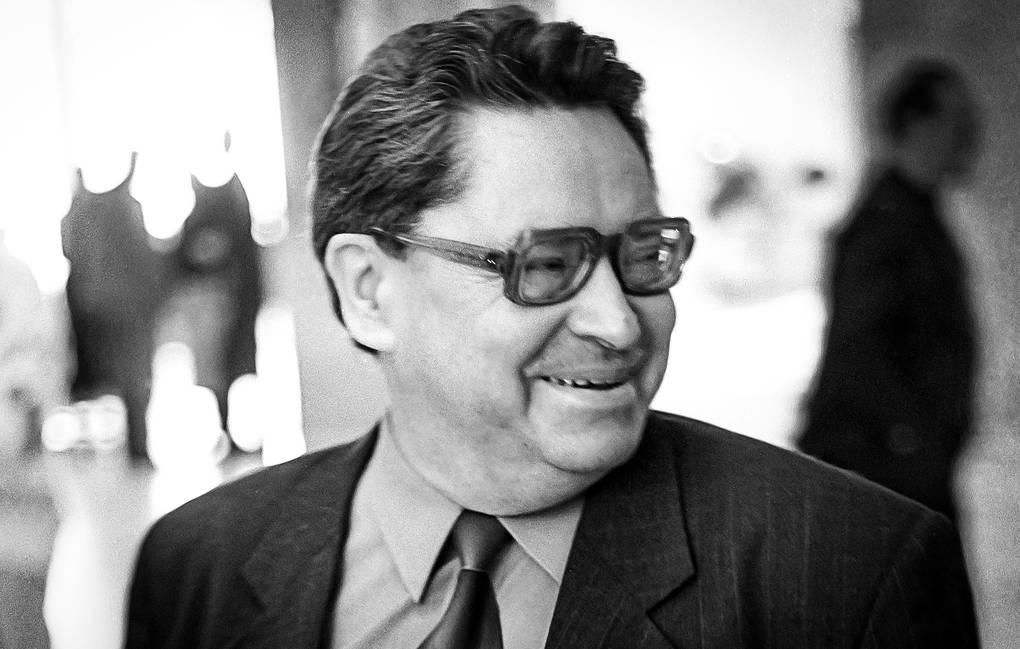In memory of RAS Academician Yuri Trutnev
News, 09 August 2021
One of the leading developers of the thermonuclear weapon in the USSR passed away on 6 August.
On 6 August 2021, Soviet and Russian physicist, RAS Academician, one of the leading developers of the thermonuclear weapon in the USSR Yuri Trutnev passed away being 93.
 RAS Academician Yuri Trutnev, 1996. Photo by Roman Yarovitsyn/TASS Russian News Agency
RAS Academician Yuri Trutnev, 1996. Photo by Roman Yarovitsyn/TASS Russian News Agency
Yuri Alexeevich Trutnev was born on 2 November 1927 in Moscow in the family of students of Timiryazev Agricultural Academy. His father Alexey Grigorievich Trutnev (1898 – 1974) later became a famous agronomist, a corresponding member of Lenin All-Union Academy of Agricultural Sciences (VASKhNIL).
Yuri Trutnev spent his childhood in Leningrad (now St. Petersburg) where his family had moved. During the Great Patriotic War, he was evacuated to the Chelyabinsk and Gorkovskaya (now Nizhny Novgorod) regions. Yuri returned to Leningrad in May 1944.
In 1945, he entered the Faculty of Chemistry of Leningrad State University (LSU, now St. Petersburg State University). After the second year of study, he transferred to the Faculty of Physics. Yuri Trutnev graduated from the LSU in 1950.
He is Doctor of Technical Sciences (1963, awarded without defence, bypassing the candidate’s degree). In 1964, he was elected a corresponding member of the USSR Academy of Sciences. In 1991, he became an Academician of the Russian Academy of Sciences (RAS). He was a member of the Department of Physical Sciences (Nuclear Physics Section) and the Presidium of the RAS Scientific Centre in Nizhny Novgorod. In 1993, he became a Professor.
After graduating from the LSU, he was assigned to the secret design bureau No.11 in Arzamas-16 of the Gorky region (later the All-Union, and now All-Russian Scientific Research Institute of Experimental Physics, VNIIEF, Sarov). Yuri Trutnev was engaged in the USSR nuclear programme. He worked under the supervision of such outstanding nuclear physicists as Yuly Khariton, Yakov Zeldovich, Andrey Sakharov, and others. Since February 1951, Yuri Trutnev was an engineer, since April 1964, he headed a department and then was Deputy Head of the Sector of Design Bureau-11. From October 1965 to 1999, Yuri Trutnev headed the VNIIEF Joint Theoretical Department. At the same time, since 1966, he was a deputy and then from 1978 the First Deputy of the Institute’s Scientific Leader. From 1999, he has held the post of the VNIIEF First Deputy Scientific Leader for promising research.
Concurrently, Academician Trutnev taught at the Department of Theoretical Physics of the National Research Nuclear University MEPhI (Moscow).
Starting from 1991, Yuri Trutnev took part in the Pugwash Conferences on Science and World Affairs. He was a member of the Sarov Branch of the Pugwash Conferences on Science and World Affairs under the RAS Presidium, which operated in 1995–2014.
Yuri Trutnev was the editor-in-chief of the VNIIEF scientific and technical collection “Issues of atomic science and technology”.
Academician Trutnev was a specialist in theoretical nuclear physics, ultrahigh pressure physics, and applied mathematics. In 1954, jointly with Andrey Sakharov and Yakov Zeldovich, he developed the radiation implosion principle (i.e. the pulsed compression of nuclear charge) and was one of the creators of the first thermonuclear (hydrogen) charge based on this principle, i.e. the two-stage hydrogen bomb RDS-37 (tested in 1955). In 1955, jointly with Yuri Babaev, he brought up the idea for improving radiation implosion and offered a new scheme: a miniaturised construction of a two-stage hydrogen charge. Its test was successfully held in 1958 within the framework of “project 49”. This idea was used for a series of other thermonuclear charges of various capacities developed in 1958 – 1962 under the leadership of Trutnev. They then became the basis for the system of the USSR’s nuclear missile weapons.
In 1961, he took part in the creation of the world’s most powerful hydrogen bomb “product 602” under the leadership of Andrey Sakharov (50-megaton “Tsar Bomb” was tested in the same year on 30 October). In 1962, he proposed an idea developed jointly with Yuri Babaev to use atomic and thermonuclear explosions for technical and scientific purposes. This idea became the basis for the programme of “peaceful nuclear explosions”: nuclear explosions were used in the USSR in 1965 – 1988 for geological exploration, the creation of technical dams, etc. Since the 1960s, Yuri Trutnev was engaged in the issues of controlled thermonuclear synthesis.
In the last years of his life, Academician Trutnev was creating modern original means of non-nuclear weapons, increasing the capabilities of strategic submarines, etc.
A Hero of Socialist Labour (1962, for the development of a series of thermonuclear charges). A Laureate of Lenin (1959, for “project 49”) and State Prizes (1984) of the USSR. He was awarded the Order of Lenin (1956, for participation in the RDS-37 creation; 1962), October Revolution (1971), the Red Banner of Labour (1975, 1987), the Gold Medal “Hammer and Sickle” (1962), the medal “For Valiant Labour” (1970).
He was a Full Knight of the Order “For Merits to the Fatherland” (in1988, III degree; in 2003, II degree; in 2012, IV degree; in 2017, I degree). He had a certificate of honour (2006) and commendation (2012) from the government of the Russian Federation.
He received the RAS I. V. Kurchatov Gold Medal “For the totality of closed works having significant scientific, military, strategic, and national economic importance and providing the country with modern safe nuclear shield”. Among his awards, there is a medal “For the rise of the Kursk Agro-Industrial Complex of the Central Design Bureau of Marine Equipment ‘Rubin'” (2002), the medal of the Russian Security Council “For the merits in ensuring national security” (2012), the medal of the Russian Ministry of Defence “For strengthening the combat commonwealth” (2017), the Rosatom decoration “For the merits to the nuclear industry” I degree (2017), and others.
Yuri Trutnev was an honorary citizen of the Nizhny Novgorod region (1997) and Sarov (2011).